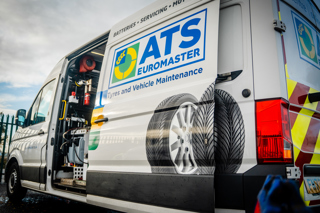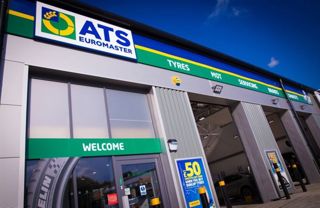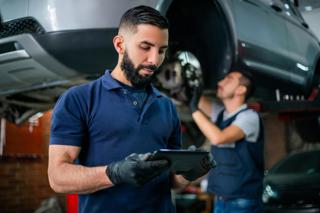Showing customers the difference in stopping distances in loaded vans focuses fleets’ minds about their tyre options, says ATS group sales director Peter Fairlie.
our patches of rubber no larger than the palm of your hand are all that’s between your car or van and the road.
Ensuring that the tyres of your vehicles are always in perfect condition and correctly inflated should be a no-brainer but, all too often, fleets and their company drivers neglect to have either the policies or the will to carry out regular checks.
That’s where ATS Euromaster comes in. The tyre distributor has increasingly moved its business proposition from a simple retailer to a provider of services; consequently, the company now supports fleets operating cars, vans and trucks from a network of 343 centres and 820 mobile service vans with at-work inspections to help pre-empt, and therefore prevent, tyre failure.
Accredited by both Safe Contractor, the health and safety assessment scheme, and the Contractors Health and Safety Scheme, ATS Euromaster also holds the Silver Award for Occupational Health & Safety from the Royal Society for the Prevention of Accidents.
Peter Fairlie, group sales director at ATS, joined the company in 2006 from van rental firm Northgate. He recognised that ATS needed to put greater emphasis on serving the needs of its customers, rather than just selling them tyres and other fast-fit products such as brakes, batteries, shock absorbers, oil and exhausts.
“When I joined, one of the things that became apparent was that we were behaving like a tyre sales business, but we needed to evolve into a service business,” says Fairlie. “Selling tyres is obviously part of that, but it’s not the only thing.”
One of the drivers for change was the fact that ATS Euromaster’s customer base is dominated by business fleets rather than retail work: it required a different mind-set to a walk-in private customer.
“Our sales mix is two-thirds B2B, one-third retail – for our competitors, it’s generally the other way round,” Fairlie says.
“It makes a difference to the way we operate our network and changes the dynamic in the centres. A retail-led network is driven by stock, but for a B2B network the focus is on delivering the customer’s fitment policy.
“For customers with a sole supply contract, we’re achieving 85-90% policy fitment. These customers are generally putting 95% of their volume through ATS.”
Key to providing an enhanced customer service, one which puts the priority on burden-free safety support rather than simply tyre sales, was introducing the mobile repair service.
“The service is fantastic for fleets, particularly those based at a hub,” says Fairlie. “We can come in overnight, inspect vehicles and then replace tyres as necessary, ready for the vehicles to be back on the road the next morning.”
However, he adds: “One area I’m surprised we haven’t seen as much take-up in is the company car market.
“It’s frustrating, but the driver still wants to drive into the centre and wait to have their tyres changed. Instead, we could go to their home or office and take care of it while they can get on with their work.
“We need to find new ways to promote the mobile offer to the driver.”
Fairlie believes that future developments in technology could see the mobile service expand to be even more proactive in identifying potential vehicle safety issues for fleet customers.
Telematics could open up a number of opportunities by analysing data direct from the vehicle’s management system. “I think telematics has the potential to be very interesting. How would we benefit from telematics, whether that’s offering our own service, or using the data?” Fairlie asks, rhetorically.
“It would be fantastic to contact customers proactively to resolve any problems, and would tie in fantastically with our mobile fitting service. There’s definite value for fleets in using that data.”
Fairlie is determined to build on ATS’s pre-emptive approach to its business, in particular to counter drivers who aren’t paying as much attention to their tyres as they should.
“Most fleets still have a 2mm tyre replacement policy, although some specific fleets will change at 3mm – but that’s not the norm,” he says.
“Of course, what we see on the vehicle and what the company’s policy is are often wide apart. Why are the drivers waiting until that point?”
He adds: “We want to offer more electronic safety inspections at customers’ sites.
“We can identify vehicles and take steps to replace. It’s likely to be harder for company cars, where they may be kept all over the country, but we think it’s key for vans.”
The media publicity surrounding cold-weather (or winter) tyres has died down over the past 12-18 months, primarily due to the mild winter conditions. A recent Fleet News online poll showed only 12.8% of fleets are planning to fit winter tyres this year.
However, ATS believes there is still growth in take-up. “We’ve seen some real successes on winter tyres, predominantly on delivery and service van fleets,” says Fairlie.
“It’s fair to say the type of fleets which have adopted winter tyres are industry leaders and they certainly wouldn’t go back to standard tyres over winter.”
Fairlie acknowledges fleet concerns over investment in a second set of tyres, but says that while there is the initial outlay, the fleet is only ever using one set of tyres.
Over the fleet lifecycle of the vehicle, tyre purchases are likely to even out if the right type is used in the right weather conditions.
Plus, of course, there are safety and operational reasons for introducing a winter tyre policy.
“Fleets have to ask if that expenditure is worth it, but if they can continue to operate, that’s a benefit. The fleets running them at the moment made that choice for valid reasons,” Fairlie says.
“We do offer a tyre hotel service, but many will store unused tyres at their own depots and workshops.”
In persuading fleets of the benefits of winter tyres, as well as the differences between budget, mid-range and premium brands, demonstrations are important.
“If you’re investing in a premium brand, you need to be sure you’re going to get that value,” Fairlie says. “If someone has doubts, they’ll probably end up going for the saving.
“We take customers down to MIRA’s test tracks and demonstrate performance.
“When you get the opportunity and the customer is open-minded, you can see their eyes opening. If you do a braking test with a loaded Transit and see the difference in stopping distance, people start to think.”
The tyre labelling scheme, introduced in 2012, is also giving customers greater awareness of the differences between products, as well as stepping up the level of competition among the premium brands who are each vying for a clean sweep of A-grades for the three measurements – wet road braking, fuel efficiency and external noise.
“Tyre labelling gives the consumer an improved product and better road safety as manufacturers want to meet the grade and criteria which means the consumer is definitely a winner,” Fairlie says.
While fleet business makes up a larger proportion of revenue for ATS than leasing company business, Fairlie says the company’s leasing work is on the rise. “Our retention rate for leasing business is very high,” he says. “These companies are very focused on driver satisfaction.”
ATS has made substantial investment in its centres in recent years. All now have wi-fi, Lavazza coffee machines and refurbished seating areas.
The growth in online retailers and associated delivery services has brought additional van fleets to ATS, Fairlie says. “It’s not just the supermarkets – parcel companies have taken on extra vehicles too,” he adds. “These fleets are much more managed than many van fleets – they’ve got processes in place from the truck sector. Uptime is critical.”


















Login to comment
Comments
No comments have been made yet.